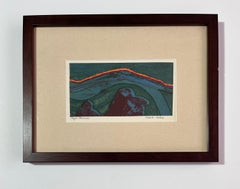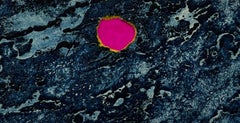Graphite Abstract Prints
to
1
1
Overall Width
to
Overall Height
to
1
78
7
3
3
1
1
1
3,255
46
24
17
12
1
Artist: Karin Bruckner
Medium: Graphite
FringeCharacter (pink, orange, abstract print)
Located in New York, NY
Monoprint with water based ink and graphite
Category
21st Century and Contemporary Contemporary Graphite Abstract Prints
Materials
Graphite, Ink, Color
$520 Sale Price
20% Off
Related Items
1960s "Magic Journeys" Teal, Pink, Orange Collage Intaglio Etching NY Artist
Located in Arp, TX
Myril Adler
"Magic Journeys"
c.1960s
Intaglio etching collage, ink on paper
6"x3" mahogany wood gallery frame 11.25"x8.25"
Signed and titled in ink
Myril Adler, was born on Septemb...
Category
1960s Abstract Graphite Abstract Prints
Materials
Paper, Ink, Intaglio
$600
H 11.25 in W 8.25 in D 1 in
1960s Blue & Pink Collage Intaglio Etching NY Artist Myril Adler
Located in Arp, TX
Myril Adler
Untitled
c.1960s
Intaglio etching collage, ink on paper
3.75"x1.75" site unframed
Signed in ink lower right
Very Good Condition- Wear consiste...
Category
1960s Abstract Graphite Abstract Prints
Materials
Paper, Ink, Intaglio
$300
H 2.75 in W 5.2 in
Grey tinted Rainbow, Geometric Abstract dazzling Op Art Framed assemblage Signed
Located in New York, NY
RICHARD ANUSZKIEWICZ
Grey Tinted Rainbow, 1992
Assemblage with 14 Color Silkscreen and Lithograph
Pencil signed and numbered 11/40 on the front
Frame included: elegantly framed in a ...
Category
1990s Op Art Graphite Abstract Prints
Materials
Mixed Media, Pencil, Lithograph, Screen
$5,200
H 41 in W 57.5 in D 2 in
1960s "Brightscape" Green, Pink, Yellow Collage Intaglio Etching NY Artist
Located in Arp, TX
Myril Adler
"Brightscape"
c.1960s
Intaglio etching collage, ink on paper
5.75"x2.5" site unframed
Signed and titled in ink
Myril Adler, was born on September 22, 1920 in Vitebsk, Ru...
Category
1960s Abstract Graphite Abstract Prints
Materials
Paper, Ink, Intaglio
1960s "Night Magic" Teal, Pink, Yellow Collage Intaglio Etching NY Artist
Located in Arp, TX
Myril Adler
"Night Magic"
c.1960s
Intaglio etching collage, ink on paper
3"x6" framed
Signed and titled in ink
Myril Adler, was born on September 22, 1920 in Vitebsk, Russia (now Be...
Category
1960s Abstract Graphite Abstract Prints
Materials
Paper, Ink, Intaglio
$600
H 11.25 in W 8.25 in D 1 in
1960s "Magic Window" Green, Pink, Yellow Collage Intaglio Etching NY Artist
Located in Arp, TX
Myril Adler
"Magic Window"
c.1960s
Intaglio etching collage, ink on paper
Image outlined in blue ink
5.75"x2.5" site unframed
Signed and titled in ink
Myril Adler, was born on Septe...
Category
1960s Abstract Graphite Abstract Prints
Materials
Paper, Ink, Intaglio
Crabs, The World is Changing Lt Ed 126/150 skateboard deck political protest art
By Ai Weiwei
Located in New York, NY
Ai Weiwei
Crabs, 2010-11
Limited Edition, hand numbered Silkscreen on 100% Canadian 2-Ply Maplewood Skateboard. Signed on the deck
31 × 1 × 3/10 inches
Edition 126/150
Signed on the ...
Category
2010s Contemporary Graphite Abstract Prints
Materials
Wood, Ink, Mixed Media, Screen
$7,500
H 31 in W 8 in D 0.3 in
Copper and Gold Leaf Variations - Abstract Mixed Media Composition
Located in Soquel, CA
Artist's proof of hand copper application and aging techniques by Patricia Pearce (American, b. 1948). Unsigned, but was acquired with other Patricia Pearce pieces. Presented in a ne...
Category
1980s Abstract Expressionist Graphite Abstract Prints
Materials
Copper, Gold Leaf
$435
H 14 in W 11 in D 0.07 in
Basquiat Philistines vs Basquiat
Located in New York, NY
In a captivating new collection, Alex Guofeng Cao dazzles audiences with his unique twist on instantly recognizable images. Inspired by history and pop culture, Cao manipulates one i...
Category
2010s Contemporary Graphite Abstract Prints
Materials
Plexiglass, Archival Ink, Mixed Media, Archival Paper, Archival Pigment
1960s "Moonscape" Red, Pink, Orange Collage Intaglio Etching NY Artist
Located in Arp, TX
Myril Adler
"Moonscape"
c.1960s
Intaglio etching collage, ink on paper
3"x6" site unframed
Signed and titled in ink
Myril Adler, was born on September 22, 1920 in Vitebsk, Russia (n...
Category
1960s Abstract Graphite Abstract Prints
Materials
Paper, Ink, Intaglio
$300
H 8.75 in W 3.75 in
Noland Yellow and Black, 54x54 Flat illusion on canvas
Located in Southampton, NY
This work is a collaboration between two artists, Joe Doyle and Diane Rosenblum. The surface of the canvas is completely flat but a remarkable three dimensional illusion is created....
Category
2010s Contemporary Graphite Abstract Prints
Materials
Canvas, Archival Ink
$9,000
H 54 in W 54 in D 2 in
Milton Glaser signed abstract mixed media landscape mid century modern (unique)
Located in New York, NY
MILTON GLASER
Untitled Abstract Landscape, 1965
Monotype with Mixed Media
11 × 13 inches
Signed and dated 1965 on the lower right recto
Unique
Frame included: held in original vinta...
Category
Mid-20th Century Abstract Graphite Abstract Prints
Materials
Mixed Media, Pencil, Graphite, Monotype, Screen
$2,000
H 11.2 in W 13.25 in D 0.3 in
Previously Available Items
SaveSesameStreet, mixed media work on paper, red, pink and yellow
Located in New York, NY
Printmaking composite with Japanese paper, pencil and silver leaf on white BFK Rives Printmaking Paper.
Paper: 38" x 30"
Frame: 41" x 33"
At the core of the dialogue between the a...
Category
2010s Contemporary Graphite Abstract Prints
Materials
Gold Leaf
PappaRazzi
Located in New York, NY
Monoprint with photo lithography, graphite, and oil based ink
Category
21st Century and Contemporary Contemporary Graphite Abstract Prints
Materials
Color, Graphite, Ink, Lithograph
DwanToDusk
Located in New York, NY
Monoprint with graphite and oil based ink
Category
21st Century and Contemporary Contemporary Graphite Abstract Prints
Materials
Color, Graphite, Ink
FringeBenefits
Located in New York, NY
Mixed media monoprint with embossing, graphite and water based ink
Category
21st Century and Contemporary Contemporary Graphite Abstract Prints
Materials
Graphite, Ink
Graphite abstract prints for sale on 1stDibs.
Find a wide variety of authentic Graphite abstract prints available on 1stDibs. While artists have worked in this medium across a range of time periods, art made with this material during the 21st Century is especially popular. If you’re looking to add Abstract prints created with this material to introduce a provocative pop of color and texture to an otherwise neutral space in your home, the works available on 1stDibs include elements of pink and other colors. There are many well-known artists whose body of work includes ceramic sculptures. Popular artists on 1stDibs associated with pieces like this include Andy Warhol, Karin Bruckner, Gary Hume, and Jack Maxwell. Frequently made by artists working in the Contemporary, Abstract, all of these pieces for sale are unique and many will draw the attention of guests in your home. Not every interior allows for large Graphite abstract prints, so small editions measuring 0.02 inches across are also available




